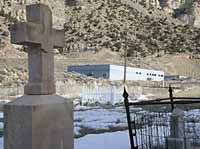| The buildings in the abandoned Willow Creek coal mine complex at Castle Gate could become a part of a proposed energy training center. A local consortium has applied for a federal grant to fund a regional program. |
For years, local groups have been trying to figure out how to tie the mineral extraction industries within the country to the knowledge of coal mining that permeates the Carbon area. Now, a group of businessmen, the college and other government agencies have come up with an idea and a possible funding source that could improve the economy in Carbon County.
About two weeks ago, an application to the United States Department of Labor from a consortium of interests requested a $2.7 million grant to build a center that would provide energy training services for the western United States.
“As the department of labor is well aware, energy related training has been identified as one of the national priorities of President Bush’s high growth job training initiative,” stated the proposal.
“Employment in these industries is becoming ever more high-tech and compliance with safety directives ever more complex. What we don’t have is a regional training program,” continued the opening statement. “It is now becoming clear that with the ever growing demand for skilled labor in the industry and the expected mass retirements of current employees, the need for energy related training both here and abroad is becoming acute.”
The initiative has already generated to training centers in Texas and New Mexico, but the facilities both concentrate on the petroleum industry. No center in the west concentrates on the coal mining industry.
The consortium applying for federal funding includes College of Eastern Utah, Southeast Applied Technology College, Southeastern Utah Energy Producers Association, vocational rehabilitation, workforce services and a numberof local participating industries.
The plan presented in the grant application proposes to develop industry specific programs and educational facilities to provide core programs for existing and incoming energy workers in the fields of technical certification, heavy equipment and trucking certification, safety awareness, emergency management and response, reclamation and hazardous waste programs, instrumentation and process control as well as industry management and leadership.
The center would also “create a series of programs aimed at coordination between industry and government.”
The center would also eventually extend itself to other locations in eastern Utah as well as to native American areas where energy reserves exist.
Proponents have stated that this center, if it is put together, will be unique in that it will put operations skills training and management under one umbrella. They have also said it could become a center where people from all over the west in many kinds of mining venues come to be training. Obviously that would bring many people to the area which could create a great deal of trickle down economic benefit in terms of lodging, dining and other support services.
As for benefits tot he industry, the grant specifies that the center could act as a conduit to bring skilled and qualified employees to the mining industry, it would create new programs for an industry with changing needs and concepts, it could be used to conduct research in new and improved energy methodologies and processes, and would also act as a type of career center for those who might want to go into energy production careers.
The grant request points out that the money from the Department of Labor, would just be the “spark plug” for further development of the center, which could eventually be not only a regional, but national influence in the energy industry with research and development as well as how it could affect the work force in various areas of the industry.
The grant points out that the center would be geared to develop into a demand-driven institution through a partnership with business interests. It would also be geared to “building the capacity of workers to obtain good jobs with good wages” through the training and certification processes.
One of the unique concepts that the proposal points out is that the energy industry is a rural industry, because very little of the energy production in the United States is done in urban areas. Therefore the new center would use a “rural strategy” in it’s operations.
However, even if the grant money comes through, there are other key pieces of the entire concept that must be arranged to make it a reality.
“We need some state appropriations to also make this work,” stated Carbon County Commissioner Steve Burge, the point man for the college in putting the application together, in a note to the Sun Advocate. “That is still up in the air.”
There is also some speculation about where such a center would be located. Some have placed it in an area north of Price where the college owns property, while others have said it will be centered in the Willow Creek Mine buildings up Price and Willow Creek Canyon. The grant itself points out the central facility would probably be the Willow Creek site. However there are still a number of details to be worked out on that facility. But as the grant points out since the center is a concept and the regional aspects of the program would affect a wide area, there would probably be a number of sites around eastern Utah from locations in the Uintah Basin to San Juan County that would be utilized for training. That training would be aided by the Utah Education Network using high speed Internet connections as well as microwave and satellite systems.
The initiative is supported by a number of well know state officials including Senators Orrin Hatch and Bob Bennett, Representatives Jim Matheson, Chris Cannon and Rob Bishop long with many other state and local officials.

